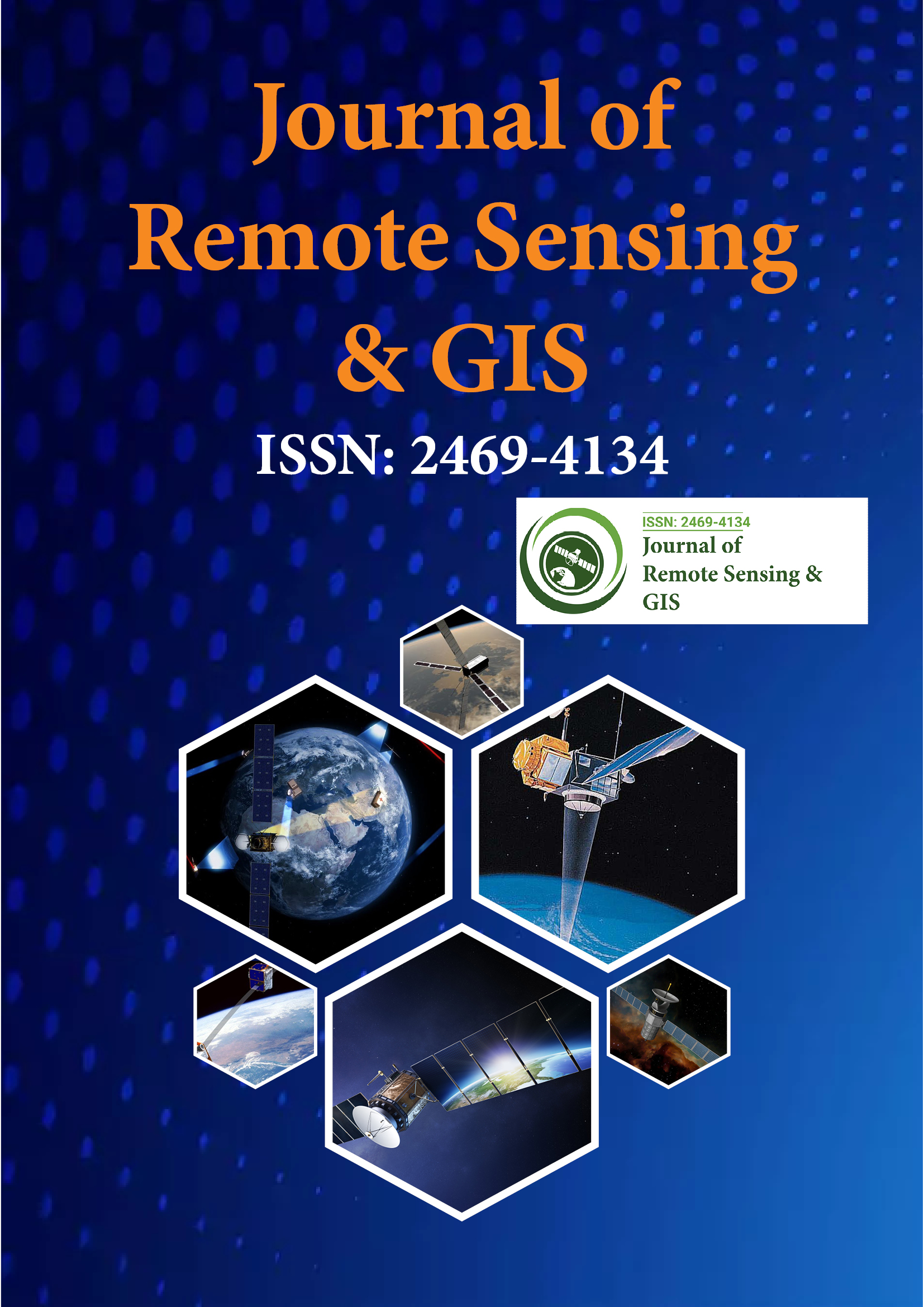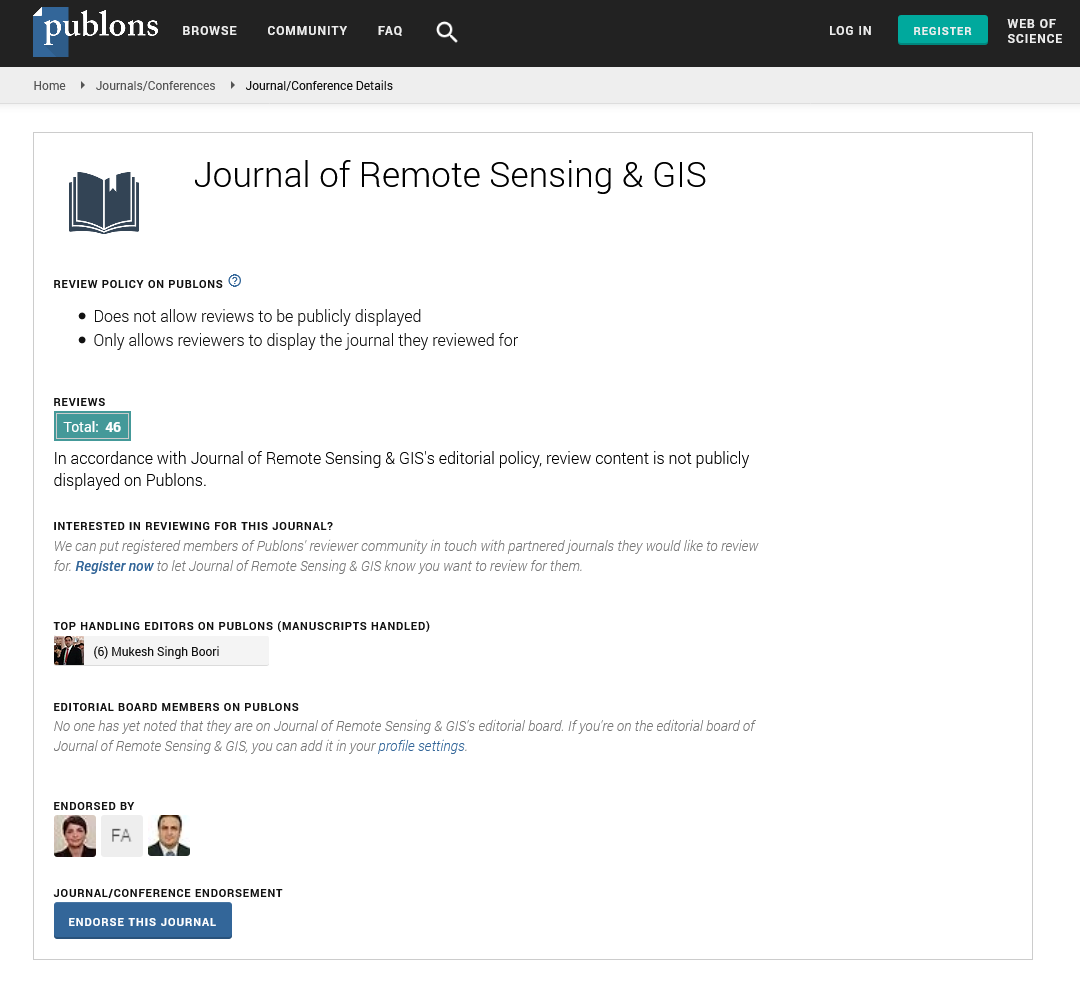Indexed In
- Open J Gate
- RefSeek
- Hamdard University
- EBSCO A-Z
- OCLC- WorldCat
- Publons
- International Scientific Indexing
- Euro Pub
- Google Scholar
Useful Links
Share This Page
Journal Flyer

Open Access Journals
- Agri and Aquaculture
- Biochemistry
- Bioinformatics & Systems Biology
- Business & Management
- Chemistry
- Clinical Sciences
- Engineering
- Food & Nutrition
- General Science
- Genetics & Molecular Biology
- Immunology & Microbiology
- Medical Sciences
- Neuroscience & Psychology
- Nursing & Health Care
- Pharmaceutical Sciences
Commentary - (2025) Volume 14, Issue 2
Remote Sensing in Precision Agriculture for Crop Health Assessment
Lei Zhang*Received: 06-Jun-2025, Manuscript No. JGRS-25-29356; Editor assigned: 09-Jun-2025, Pre QC No. JGRS-25-29356 (PQ); Reviewed: 23-Jun-2025, QC No. JGRS-25-29356; Revised: 30-Jun-2025, Manuscript No. JGRS-25-29356 (R); Published: 07-Jul-2025, DOI: 10.35248/2469-4134.24.14.383
Description
Modern agricultural systems face mounting pressures from climate variability, resource constraints and increasing food demand. To address these challenges, precision agriculture has emerged as an approach that applies site-specific management techniques to optimize crop production. A key component of precision agriculture is the ability to monitor crop health and detect problems early. Remote sensing provides a non-invasive, efficient and scalable means of observing field conditions and assessing plant status over time and space.
Satellite and drone-based remote sensing platforms collect data in various spectral bands, including visible, near-infrared and thermal regions. This spectral information is useful for identifying signs of stress in vegetation that are not apparent to the naked eye. For instance, stressed plants often exhibit changes in chlorophyll content, water retention and canopy structure that affect their reflectance characteristics. By analyzing these spectral responses, remote sensing tools can detect nutrient deficiencies, disease outbreaks, water stress and pest infestations before significant yield losses occur.
Vegetation indices are among the most commonly used tools for crop health monitoring. The Normalized Difference Vegetation Index (NDVI), derived from red and near-infrared reflectance, is widely applied to evaluate plant vigor and greenness. Other indices such as the Soil-Adjusted Vegetation Index (SAVI), Enhanced Vegetation Index (EVI) and Normalized Difference Water Index (NDWI) offer additional insights into specific conditions like soil background effects and plant water content. These indices are calculated from remotely sensed imagery and mapped across agricultural fields to identify spatial variability in crop performance.
In practice, remote sensing supports a wide range of decisions throughout the crop cycle. During early stages of growth, imagery can be used to assess germination success and ensure uniform crop establishment. Mid-season monitoring helps detect anomalies and prioritize field scouting. For example, areas with sudden NDVI decline may signal disease pressure or irrigation failure. Targeted intervention in these zones can prevent the spread of problems and reduce unnecessary input use elsewhere. Near harvest, remote sensing provides estimates of biomass, crop maturity and yield potential, which assist in harvest planning and market forecasting.
Drone-based imaging systems offer high-resolution views of fields, often capturing details at the scale of individual plants. Equipped with multispectral or hyperspectral sensors, drones can fly on-demand to gather imagery during key growth stages. Their flexibility and rapid deployment make them well suited for smallholder and research farms where regular monitoring is needed. Satellite platforms, on the other hand, provide broader coverage and regular revisit times, making them ideal for regional crop surveillance and seasonal comparisons. New-generation satellites like Sentinel-2 and Landsat 8 deliver free and frequent imagery that is widely used for agricultural monitoring.
Thermal infrared remote sensing adds another layer of information by measuring surface temperature. Crops under water stress often exhibit higher leaf temperatures due to reduced transpiration. Thermal imagery, therefore, supports irrigation management by identifying zones that require more or less water. This application is particularly relevant in arid regions and in high-value crops like vineyards and orchards. Integration of thermal data with vegetation indices enhances the ability to manage inputs efficiently and conserve water resources.
Remote sensing is also used in combination with crop growth models to simulate yield outcomes and predict harvest quality. By providing real-time data on canopy development, leaf area index and phenology, satellite inputs improve the calibration of these models. When combined with weather and soil data, remote sensing-based modeling supports decisions on fertilizer application, disease control and resource allocation.
The adoption of remote sensing in agriculture has been facilitated by cloud-based platforms and user-friendly interfaces. Tools such as Google Earth Engine, CropScape and private agricultural dashboards enable farmers and agronomists to access processed imagery, perform analysis and visualize field variability without requiring advanced technical skills. These platforms also support mobile integration, allowing data to be collected in the field and linked to remote sensing outputs for validation and management decisions.
Challenges to widespread adoption remain, including the cost of high-resolution imagery, limited connectivity in rural areas and the need for localized calibration. The accuracy of vegetation indices can be affected by factors such as soil background, atmospheric conditions and crop type, requiring site-specific adjustment. Additionally, interpretation of remote sensing data requires contextual knowledge of the crop system and management practices. Training and support services are essential to help users translate imagery into actionable insights.
In conclusion, remote sensing is transforming crop health assessment by enabling timely, spatially detailed and objective monitoring of agricultural fields. Through the use of spectral indices, thermal data and drone imagery, farmers and agronomists can detect problems early, manage inputs precisely and improve overall productivity. These technologies support more sustainable and informed decision-making, reducing input costs and minimizing environmental impacts. As remote sensing tools become more accessible and integrated into farm operations, they will play an increasingly important role in the evolution of precision agriculture and food system resilience.
Citation: Zhang L (2025). Remote Sensing in Precision Agriculture for Crop Health Assessment. J Remote Sens GIS.14:383.
Copyright: © 2025 Zhang L. This is an open-access article distributed under the terms of the Creative Commons Attribution License, which permits unrestricted use, distribution and reproduction in any medium, provided the original author and source are credited.

